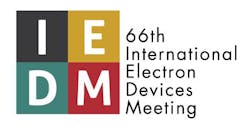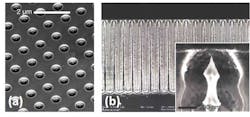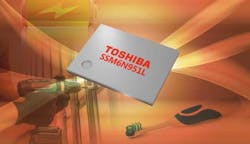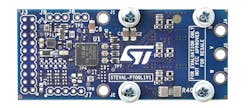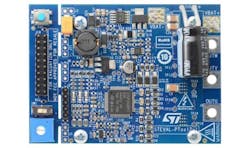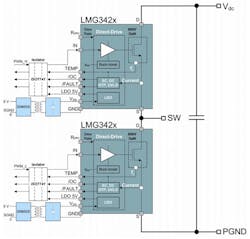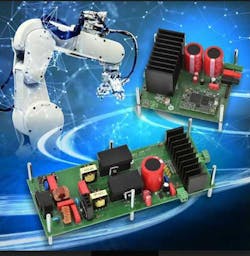This Week in PowerBites: Silicon Vacuum Tubes, Electric Motorcycles
What the Heck are Silicon Vacuum Tubes? Find Out at IEEE's Virtual IEDM
Diamond-based transistors, silicon vacuum devices, and other advanced power technologies will constitute one of several prominently featured areas of exploration at the 66th annual edition of the IEEE International Electron Devices Meeting (IEDM), held as a virtual event this year from Saturday through Friday, December 12-18, 2020. The event will offer a mix of live-streamed events and on-demand pre-recorded presentations, with a schedule of live Q&A sessions. IEDM will offer its online attendees a rich program of tutorials, short courses, and a technical program with over 220 papers. Visitors will also be able to participate in the live-streamed events, such as the plenary presentations, panel discussion, and career session.
One of the highlights of this year's IEDM program will be Plenary Session 5, titled "Power Devices and Systems - Recent Advances in Power Electronic Devices,” held on Monday, Dec. 14, 9:00-10:00 am. It will include "Demonstration of a ~40 kV Si Vacuum Transistor as a Practical High Frequency and Power Device," where the authors provide details on how they fabricated the first silicon-based vacuum transistor capable of operating with ~40-kV applied bias. They will also explain why their data indicates that devices based on a vacuum drift region can outperform semiconductors for high frequency and power applications.
Other power-related topics covered in Plenary Session 5 include:
- Development of High-Voltage Vertical GaN PN Diodes
- 3.3 kV Back-Gate-Controlled IGBT (BC-IGBT) Using Manufacturable Double-Side Process Technology
- 4 5 kV Multi-Channel AlGaN/GaN Power Schottky Barrier Diodes with Junction-Fin-Anode
- Diamond Semiconductor Devices: State-of-the-Art of Material Growth and Device Processing
Among the non-power-related technical highlights of IEDM 2020 are:
- Novel 3D breakthroughs for increased CMOS performance – Intel will describe a stacked NMOS-on-PMOS nanoribbon architecture. UC-Santa Barbara and Xi’an Jiaotong University will discuss a growth technique for CMOS-compatible graphene interconnects.
- Quantum computing – Imec/KU Leuven researchers will give details of a 300-mm silicon design platform for use in better understanding material properties at cryogenic temperatures, and other aspects of qubit design.
- Advances in imaging – Samsung will detail a single-chip LiDAR beam scanner as well as an ultra-high-resolution mobile CMOS imager.
- High-speed devices – Cornell and Intel will describe the first p-channel GaN transistors to break the gigahertz speed barrier, with 20-GHz performance.
- Toward a lab-on-a-chip – A team led by Suzhou Institute of Technology will detail a large-area active-matrix-array-based multifluidics platform for bio-sample handling, with far higher resolution than alternatives.
- Better glaucoma monitoring – A Samsung/Caltech team will discuss a highly miniaturized, battery-free implantable sensor for monitoring intraocular eye pressure.
This year’s theme is “Innovative Devices for a Better Future,” which reflects the fact that, at a time of great global uncertainty, electronics technology is being used much more broadly than ever before to address the world’s most pressing challenges.
Click here for more information about IEDM '20
Click here to register for IEDM '20
Compact Low On-Resistance MOSFET Enhances Li-Ion Battery-Pack Operation
Toshiba Electronics Europe has expanded its portfolio of power-saving N-channel MOSFETs with the introduction of the SSM6N951L, a device specifically intended for use in battery-protection circuitry incorporated into lithium-ion (Li-ion) battery packs. Its ultra-low on-resistance (4.6 mΩ maximum at a VGS of 3.8 V) and minimal gate-source leakage current (1 μA maximum at a VGS of 8 V) allow it to run much cooler than other comparable devices. Thus, it can support quicker charge rates as well as enjoy greater reliability and a longer operational lifespan.
These new MOSFETs are shipped in low-profile TCSP6A-172101 format packages (with dimensions of 2.14 × 1.67 × 0.11 mm). As a result, they’re optimized for implementation in modern space-limited battery-powered equipment. For more information, visit: https://toshiba.semicon-storage.com/eu/semiconductor/product/mosfets/detail.SSM6N951L.html.
Plug-and-Play Prototype Boards Simplify Development of Cordless Power Tools
STMicroelectronics introduced two new plug-and-play boards for controlling three-phase brushless motors in state-of-the-art cordless home and garden power tools powered by up to 56-V Li-ion batteries. Based on ST’s highly integrated STSPIN32 motor-control systems-in-package, the STEVAL-PTOOL1V1 and STEVAL-PTOOL2V1 evaluation boards fulfill key requirements of power tools including small dimensions and low standby current.
Firmware is supplied for six-step motor commutation using Hall-effect rotor-position sensing, which ensures low torque ripple and optimum power efficiency. In addition to cordless tools, the boards can be used in any battery-operated applications that utilize brushless three-phase motors with single-shunt control.
The STEVAL-PTOOL1V1 for equipment powered by Li-ion battery packs from two cells (7.4 V) to six cells (22.2 V) has a 70- × 30-mm footprint and delivers up to 15-A continuous current. Standby current is less than 1 µA. At the heart of the board is the STSPIN32F0B motor controller, which contains an STM32F0* microcontroller, three-phase half-bridge gate driver, 12- and 3.3-V voltage regulators, an op amp for current sensing. and power-stage protection features.
The STEVAL-PTOOL2V1, for battery sizes from eight cells (29.6 V) to 15 cells (55.5 V), can deliver up to 19-A continuous current. It’s controlled by ST’s STSPIN32F0252 motor controller, which contains a three-phase 250-V gate driver, an STM32F0* microcontroller, and a comparator designed to offer very fast and flexible OCP.
Both boards provide a potentiometer for speed variation, inputs for trigger and rotation-direction setting, thermal shutdown, and protection against reverse biasing of power-stage outputs. They’re supplied with a heatsink already mounted. The STEVAL-PTOOL1V1, priced at $41.00, and STEVAL-PTOOL2V1, $69.00, are available now. The STSW-PTOOL1 firmware for the development boards can be downloaded free of charge from www.st.com/stspin-pr.
Automotive-Grade GaN FETs Integrate Driver, Protection, Active Power Management
Texas Instruments introduced its next generation of 650- and 600-V gallium-nitride (GaN) field-effect transistors (FETs) for automotive and industrial applications. The new GaN FETs feature improved thermal performance as well as an integrated fast-switching, 2.2-MHz gate driver, internal protection functions, and temperature sensing, which eliminates more than 10 components typically required for discrete solutions.
TI says that the new GaN FETs can help engineers create onboard EV chargers and dc-dc converters that deliver twice the power density, achieve 99% efficiency, and reduce the size of power magnetics by 59% compared to existing solutions. They can also produce similar improvements in the ac-dc converters that power hyperscale and enterprise computing platforms and 5G telecom infrastructure.
Each of the new 30-mΩ FETs can support up to 4 kW of power conversion when applied in a half-bridge configuration. TI's new GaN FETs also support an "ideal diode mode" that allows them to reduce the power losses that tend to occur at higher switching frequencies.
For example, in PFCs, ideal diode mode reduces third-quadrant losses by up to 66% compared to discrete GaN and SiC metal-oxide silicon FETs (MOSFETs). Ideal diode mode also eliminates the need for adaptive dead-time control, reducing firmware complexity and development time. To learn more about this feature, read the application note, “Maximizing the Performance of GaN with Ideal Diode Mode”.
Pre-production versions of the four new industrial-grade, 600-V GaN FETs are available now, only on www.TI.com, in a 12- × 12-mm, quad flat no-leads (QFN) package with pricing listed in the table below. TI expects the industrial devices to ship in volume production in the first quarter of 2021. Evaluation modules are available for purchase on TI.com starting at US$199.
Pre-production versions of the new LMG3522R030-Q1 and LMG3525R030-Q1 650-V automotive GaN FETs and evaluation modules are expected to be available for purchase on the company’s site in the first quarter of 2021. Engineering samples are available upon request at www.ti.com/autogan. For additional information, visit www.ti.com/LMG3425R030-pr and www.ti.com/LMG3525R030-Q1-pr.
Motor Dev Kit Accelerates Designs, Boosts Efficiency for Apps from >1 kW to 10+ kW
ON Semiconductor unveiled its advanced and flexible Motor Development Kit (MDK), created to accelerate the development of more efficient motor-control solutions for applications ranging from less than 1 kW to over 10 kW. The platform, which combines hardware, software, and power modules, addresses the urgent need for improved energy efficiency, especially in ac induction motors, which have an average efficiency of just 44%.
The MDK is one of a growing number of ON Power Boards, designed to connect directly to the company's so-called Universal Controller Board (UCB). The UCB features an array of strategically selected pre-engineered inverter-based motor-drive solutions that range from high-voltage integrated modules to low voltage, discrete MOSFETs.
The UCB serves as a common control platform that interfaces with any Power Board to enable engineers to evaluate alternative motor-control techniques for various types of motors and at a wide variety of power levels. The board supports a flexible and programmable approach to motor control based on Xilinx's unique Zynq-7000 SoCs that integrate two Arm Cortex-A9 processor cores with an FPGA fabric. The board also features a 10-channel differential ADC, 12 PWM channels, and a number of configurable digital peripherals. Communication ports include USB, JTAG, and UART, as well as a Gigabit Ethernet PHY.
The MDK currently supports two motor power boards: the SECO-1KW-MCTRL-GEVB, which is suitable for driving motors up to 1 kW, and the SECO-MDK-4KW-65SMP31-GEVB for driving motors up to 4 kW. Both power boards use ON Semiconductor's IPM technology and will be available in Q4 2020.
ON Semi's website also hosts a very informative video on the platform's components and operation that can be viewed by clicking here.
Buck-Boost DC-DC Converter with Ultra-Low IQ Extends Battery Life of Wireless, Smart IoT Devices
The ISL9122A from Renesas Electronics Corp. is a flexible buck-boost switching regulator with bypass mode that provides ultra-low quiescent current (IQ) for powering sensors, microcontrollers (MCUs), wireless devices, and other system components. Thanks to its ability to operate across a wider range of battery voltages (1.8 to 5.5 V), the ISL9122A can extend the battery life of smart IoT devices powered by coin-cell, lithium, and multiple series alkaline batteries. Target applications include wireless earbuds, fitness bands, smart watches, water and gas meters, portable medical devices, and a wide range of battery-operated smart IoT devices.
The ISL9122A buck-boost switching regulator implements dynamic voltage scaling (DVS) in I2C-programmable 25-mV steps to optimize system power consumption. The regulator’s power boost up to 5.375 V maximizes RF capabilities of IoT devices across their battery range. And its PFM and PWM functionality maximizes efficiency over the whole output current range. In forced PWM mode, the regulator always switches at 2.5-MHz frequency, which improves the system’s EMI performance.
Key Features
- Ultra-low IQ <1.3 µA and low shutdown mode current of 7 nA to extend battery life
- High efficiency at light load (84% @ 10 µA) and 97% peak efficiency
- Automatic and selectable forced bypass power-saving mode reduces IQ
- Large adjustable output-voltage range from 1.8 to 5.375 V in 25-mV increments
- Max output current up to 500 mA (VOUT = 3.3 V, VIN = 3.6 V)
Pricing and Availability
The ISL9122A is available now from Renesas’ worldwide distributors and is priced at $0.89 USD (8-lead DFN package) and $0.78 USD (8-bump WLCSP package), each in 1,000-unit quantities. For more information, visit www.renesas.com/products/ISL9122A.
Two ISL9122A evaluation boards are also available: The ISL9122AIRN-EVZ with 3.3-V default output (DFN) and ISL9122AIIN-EVZ with 3.3-V default output (WLCSP), both priced at $70 USD.
New Electric Motorcycles Are Fast, Sexy, and Eco-Friendly
When Soriano Motorcycles’ line of hand-crafted, electric ballistic vehicles enters production in the spring of 2021, their strong performance, unique technical features, and passionate styling may finally make e-bikes sexy, in the same way the Tesla Roadster did for EVs. Even the company itself is unique, a "re-startup" of Soriano Motori, a family owned manufacturing firm that produced stylish scooters, powerful outboard motors, and other power equipment back in the 1930s and 40s.
The new company's CEO, Marco Soriano, a descendant of the first company's founder, has created three limited production motorcycles that honor the graceful styling of their predecessors and echo their sprit of quirky technical innovation. Featuring twin electric motors, a five=speed transmission (with reverse) and a top speed of 140 mph, these pricey, bespoke machines deliver both style and performance.
For additional details, visit the Soriano website. Also, stay tuned for our review "New Electric Motorcycles Speak Performance with a Sexy Italian Accent,” coming very soon.

